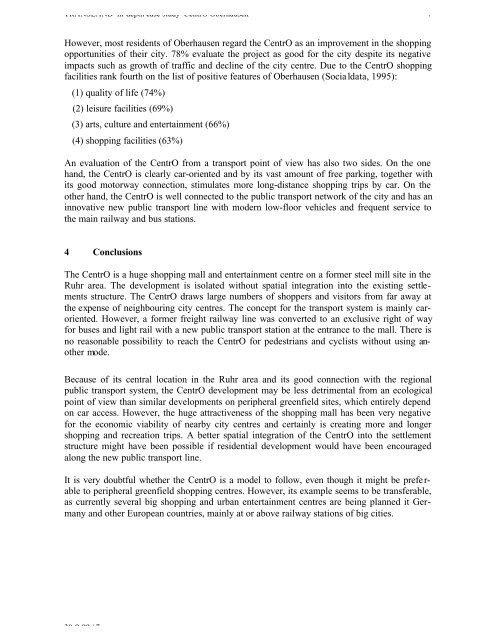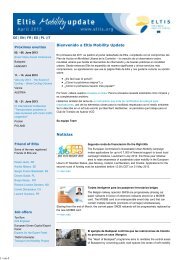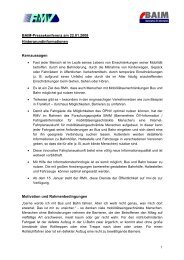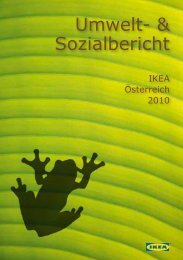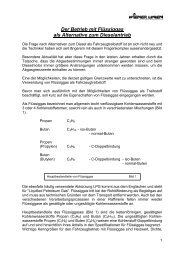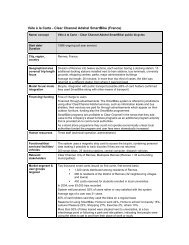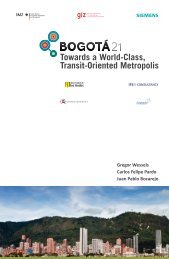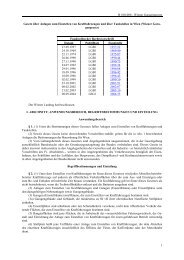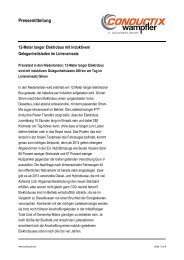CentrO Oberhausen - Eltis
CentrO Oberhausen - Eltis
CentrO Oberhausen - Eltis
You also want an ePaper? Increase the reach of your titles
YUMPU automatically turns print PDFs into web optimized ePapers that Google loves.
TRANSLAND in-depth case study <strong>CentrO</strong> <strong>Oberhausen</strong> 7<br />
However, most residents of <strong>Oberhausen</strong> regard the <strong>CentrO</strong> as an improvement in the shopping<br />
opportunities of their city. 78% evaluate the project as good for the city despite its negative<br />
impacts such as growth of traffic and decline of the city centre. Due to the <strong>CentrO</strong> shopping<br />
facilities rank fourth on the list of positive features of <strong>Oberhausen</strong> (Socialdata, 1995):<br />
(1) quality of life (74%)<br />
(2) leisure facilities (69%)<br />
(3) arts, culture and entertainment (66%)<br />
(4) shopping facilities (63%)<br />
An evaluation of the <strong>CentrO</strong> from a transport point of view has also two sides. On the one<br />
hand, the <strong>CentrO</strong> is clearly car-oriented and by its vast amount of free parking, together with<br />
its good motorway connection, stimulates more long-distance shopping trips by car. On the<br />
other hand, the <strong>CentrO</strong> is well connected to the public transport network of the city and has an<br />
innovative new public transport line with modern low-floor vehicles and frequent service to<br />
the main railway and bus stations.<br />
4 Conclusions<br />
The <strong>CentrO</strong> is a huge shopping mall and entertainment centre on a former steel mill site in the<br />
Ruhr area. The development is isolated without spatial integration into the existing settlements<br />
structure. The <strong>CentrO</strong> draws large numbers of shoppers and visitors from far away at<br />
the expense of neighbouring city centres. The concept for the transport system is mainly caroriented.<br />
However, a former freight railway line was converted to an exclusive right of way<br />
for buses and light rail with a new public transport station at the entrance to the mall. There is<br />
no reasonable possibility to reach the <strong>CentrO</strong> for pedestrians and cyclists without using another<br />
mode.<br />
Because of its central location in the Ruhr area and its good connection with the regional<br />
public transport system, the <strong>CentrO</strong> development may be less detrimental from an ecological<br />
point of view than similar developments on peripheral greenfield sites, which entirely depend<br />
on car access. However, the huge attractiveness of the shopping mall has been very negative<br />
for the economic viability of nearby city centres and certainly is creating more and longer<br />
shopping and recreation trips. A better spatial integration of the <strong>CentrO</strong> into the settlement<br />
structure might have been possible if residential development would have been encouraged<br />
along the new public transport line.<br />
It is very doubtful whether the <strong>CentrO</strong> is a model to follow, even though it might be preferable<br />
to peripheral greenfield shopping centres. However, its example seems to be transferable,<br />
as currently several big shopping and urban entertainment centres are being planned it Germany<br />
and other European countries, mainly at or above railway stations of big cities.<br />
30-9-99 / 7


